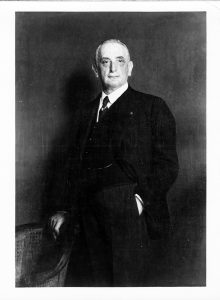A View from 100 Years Ago
I recently spent some time reviewing the President’s Report section of the Annual Report of The Mount Sinai Hospital from 1921 (linked here, starting on page 190). The President then was George Blumenthal, a devoted trustee, and a smart businessman who had recently guided the Hospital through a major expansion program, the uncertainties of World War I, and the influenza epidemic of 1918. Reading the report reminded me of the joys – and problems – with reading primary historical sources: it is very easy in hindsight to see connections between two times that may not be related, and simple observations can seem very prescient.
Don’t get me wrong, parts of the report are very dated and irrelevant to today: the Hospital was unable to afford radium to use in patient treatment, and so that service was not provided. There was also a section on issues related to fund raising through the Federation of Jewish Charities (today’s UJA-Federation). But still, there were many issues that would seem familiar to our current leaders. The Hospital was perennially short of money, but after the epidemic and the war, wages were rising quickly for what today would be called “essential workers”. Adding to this was a restrictive immigration policy that limited the labor pool. The inability to hire as many trained nurses as they needed was a continuing struggle as well, something the whole country recognizes today.

George Blumenthal, President of The Mount Sinai Hospital from 1911-1938
And yet Blumenthal made the case – as we do today – for why private hospitals like Mount Sinai deserve the philanthropic support of the people. He says:
It is absolutely essential that private institutions like Mount Sinai should be leaders of progress in hospital work…. To discover, test and demonstrate new methods of treatment is recognized as one of the functions of private institutions and it is one of the strongest reasons for their existence and constitutes their most important claim on the generosity of the public which supports them.
A couple of pages later, Blumenthal makes a bold statement about the importance of Mount Sinai being a teaching hospital. At this time it had loose clinical ties to both Columbia and NYU. He envisioned something more:
A Hospital possessing the clinical and laboratory resources of Mount Sinai should have university affiliation or if this be impracticable should independently utilize its organization for teaching purposes, for in no other way can the fullest benefits be derived from the intensive study of interesting, varied and often perplexing clinical material. We hope the day is not very far off when work on these lines can be done either through affiliation with one of the many teaching institutions located in our city or by independent action.
And “independent action” it was. Even with academic affiliations with various medical schools, in the 1950s Mount Sinai was not satisfied that they were living up to their potential in terms of training the next generation of physician/scientists or using their immense clinical material for creating new medical knowledge to advance patient care. In 1963, the Trustees received a charter to create their own medical and graduate schools. The Mount Sinai School of Medicine opened in 1968.
